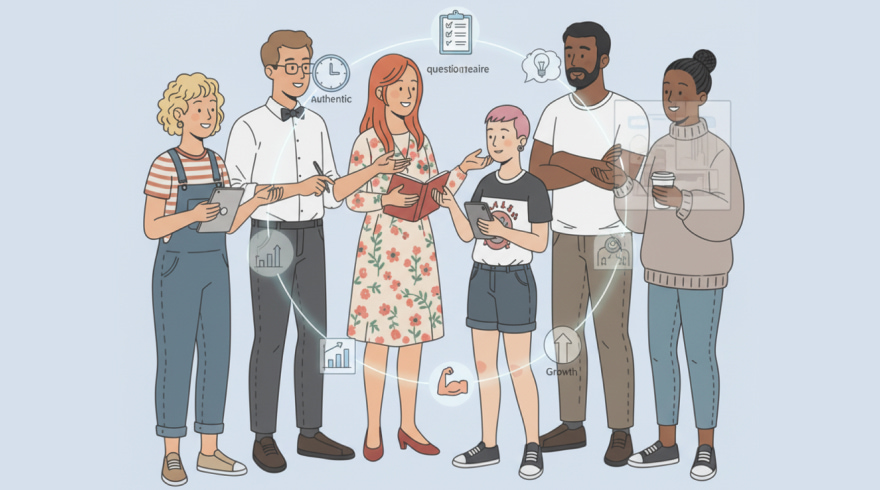
Understanding the Concept of Leadership Questionnaire
Leadership influences how teams communicate, solve problems, and deliver outcomes, so a structured way to explore one’s approach can be a catalyst for lasting improvement. In many organizations, a leadership styles questionnaire becomes the shared language that turns fuzzy impressions into observable patterns leaders can actually adjust with intention. By translating behaviors into measurable dimensions, it allows people to compare tendencies, spot blind spots, and experiment with new tactics without stigma. The resulting insight is both personal and actionable, bridging the gap between awareness and daily habits.

Consider the challenge of leading across hybrid or distributed environments, where clarity, trust, and momentum can fray without deliberate effort. In these settings, a leadership trait questionnaire reframes leadership as a mosaic of strengths rather than a single style, encouraging nuanced adaptation to context. This framing helps emerging leaders move beyond labels, and it prompts seasoned managers to rethink how they coach, delegate, and prioritize. With a clear snapshot, people can select a growth theme for a quarter, track experiments, and iterate with feedback.
Clarity also benefits cross-functional initiatives where decision rights, collaboration norms, and cadence must be renegotiated. For program leads and department heads, a manager questionnaire offers a quick diagnostic to align expectations before complexity compounds. The output equips teams to negotiate “how we work” agreements, minimizing friction and accelerating execution. The result is a smoother runway for strategic projects, fewer handoff failures, and a stronger sense of psychological safety across disciplines.

- 1Builds a common vocabulary for discussing leadership behaviors.
- 2Encourages evidence-based reflection rather than gut-feel judgments.
- 3Creates a baseline to track development progress over time.
What Leadership Styles Questionnaire Measure?
High-quality instruments typically assess dimensions such as communication clarity, coaching orientation, accountability rigor, and change agility. When interpreted alongside real work scenarios, a leadership behavior questionnaire highlights specific inflection points where small shifts yield outsized gains. Rather than awarding generic “scores,” the best approaches map behaviors to situational demands, enabling leaders to calibrate style in moments that matter most.
| Dimension | What It Reveals | Sample Prompt |
|---|---|---|
| Clarity | How consistently expectations and outcomes are communicated | I set milestones and confirm mutual understanding during planning. |
| Coaching | How often you develop others through feedback and inquiry | I ask questions that help teammates generate their own solutions. |
| Accountability | How you balance autonomy with follow-through | I agree on check-ins and follow up on commitments without delay. |
| Adaptability | How you adjust style to context and stakeholder needs | I vary my approach when priorities or constraints shift suddenly. |
Interpretation improves when you triangulate multiple signals such as self-ratings, peer feedback, and outcome metrics, and then anchor insights in current priorities. In practice, a leadership assessment questionnaire becomes most valuable when it is paired with a concrete development plan and time-bound experiments. The combination helps translate numbers into behavior change, making growth visible and sustainable. Customization also matters because industry dynamics and team maturity influence which behaviors are most pivotal right now. For leaders building change-ready cultures, a leadership style questionnaire can foreground adaptability and communication cadence while still tracking accountability rigor. By aligning the lens to strategy, the instrument serves as a steering mechanism rather than a static report.
Measure Your Progress
Personal benefits include clearer self-understanding, stronger decision hygiene, and improved relationship management. For individual contributors on a leadership track, a leadership skills assessment questionnaire clarifies which strengths to double down on and which habits to stretch in the coming cycle. This specificity enables targeted practice, efficient coaching sessions, and measurable progress tied to business goals.

- 1Teams reduce friction by aligning on norms for meetings, updates, and feedback.
- 2Managers sharpen delegation, empowering people while preserving accountability.
- 3Organizations unlock culture change by scaling common practices, not slogans.
- 4HR partners gain clean data to design relevant learning paths and coaching.
Team-level benefits surface as smoother coordination, faster conflict resolution, and a shared rhythm for decision making. When scaling quickly, a questionnaire leadership style tool gives squads a mirror to tune collaboration without waiting for quarterly surveys. Beyond momentum, individual reflection deepens when people compare notes with peers using a leadership questionnaires self assessment format that invites examples from recent projects. The blend of structured prompts and narrative context brings nuance to development conversations and reinforces accountability to action.

Leadership Self-Assessment Questionnaire Insights
Rollouts work best when positioned as growth tools rather than performance verdicts, supported by psychological safety and clear communication. To set the right expectations, a leadership self-assessment questionnaire is introduced with guidance on confidentiality, purpose, and how insights will inform coaching. The emphasis should be on experimentation and learning, not labeling or ranking people. With that frame, participation rises and candor improves. Data quality hinges on thoughtful timing, brief surveys, and context-rich debriefs that connect dots to day-to-day execution. Leaders often get sharper about priorities when a time management questionnaire is integrated into the same development cycle, highlighting trade-offs that influence behavior shifts. This pairing helps people allocate attention to the few moments that create leverage across their teams. As a result, behavior change becomes more focused and durable.

Ethical use requires transparency about data handling, opt-in participation, and the avoidance of one-size-fits-all prescriptions that ignore culture. In values-driven environments, an authentic leadership questionnaire can complement behavioral diagnostics by exploring alignment between stated principles and lived actions. The combination respects the human side of work while still providing objective insight for improvement. When paired with coaching, retrospectives, and regular check-ins, the entire system becomes a practical engine for growth.
- 1Explain how findings will be used and who can access reports.
- 2Combine self, peer, and manager perspectives for a fuller picture.
- 3Translate results into two or three specific experiments per month.
Frequently Asked Questions
- What does this kind of survey measure in practice?
It measures recurring behaviors across moments such as planning, communication, coaching, and follow-through. In most organizations, a leadership questionnaire aligns items to concrete scenarios so people can connect their answers to real decisions. That connection encourages action rather than abstract reflection, which is essential for long-term adoption.
- How reliable are the results across different teams?
Reliability improves with clear definitions, multiple perspectives, and consistent administration. For supervisory roles, a leadership questionnaire for managers includes items specific to delegation, prioritization, and stakeholder alignment to preserve fairness. Triangulating with feedback and outcomes helps confirm patterns and reduce bias.
- Where can I find examples of prompts and scales?
Most high-quality instruments include sample prompts that highlight tone, specificity, and rating anchors. For trial runs, a free leadership questionnaire can demonstrate structure and wording before you invest in a full rollout. The key is to pilot with a small group, collect feedback, and refine.
- How often should a leader retake the survey?
Quarterly or semiannual cycles work well because they leave enough time to implement experiments and observe impact. Retesting too quickly can blur signal with short-term noise, while waiting a full year can slow momentum on critical habits.
- Should hiring decisions rely on these results?
These tools are best used for development and onboarding rather than as sole hiring filters. If used in selection, they should augment structured interviews and work samples, with transparent candidate consent and careful interpretation.<
The Latest News
Please Note
This website (leadershipstylesquestionnaire.com) is not an official representative, creator or developer of this application, or product. All the copyrighted materials belong to their respective owners. All the content on this website is used for educational and informative purposes only.



